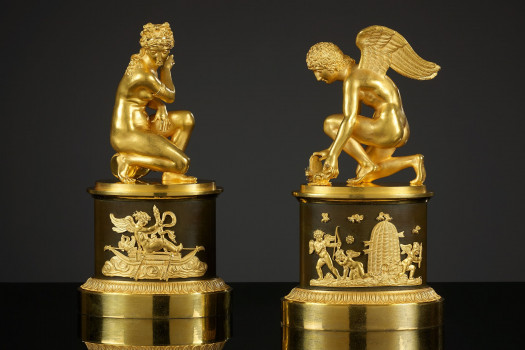Pair of French Empire Sculptures after a design of Antoine-Denis Chaudet (1763-1810)
Kollenburg Antiquairs BV
To Antoine-Denis Chaudet; probably made by Pierre-Philippe Thomire
France, ca. 1805
31 cm height
Original condition
Two gilt-bronze statuettes on an oval shaped pedestal representing Amor and Psyche. The pedestals, on a plain gilt bronze plinth decorated with a palmette fringe, have a plain oval shaped trunk decorated with ormolu appliques. The pedestal of Psyche is decorated with a winged putto sitting on a cloud. The pedestal of Amor is decorated with a beehive and putti. Both statuettes are after models of Chaudet en most probably manufactured by Thomire. The representation of Amor who has captured a butterfly by its wings symbolizes the entrapment of the soul (Psyche). The myth of Amor and Psyche is significant during the neoclassical period. There are two known works by Canova that are based on this myth. Chaudet used the elaboration of this myth to express the harmony and finesse of the human body in marble. The figure of the crouching Aphrodite is an interpretation of a Roman marble sculpture that Chaudet has construed to fit the prevailing taste of the neoclassical period. Antoine-Denis Chaudet (1763-1810) Chaudet was a pupil of Jean-Baptiste Stouf and Étienne Gois sr. In 1784 he earned the Prix de Rome with a plaster relief and went to Rome to study at the Académie de France. In 1789 he returned to Paris where he was accepted to the Académie Royale de Peinture et de Sculpture. At the Salon of Paris in 1801 he presents a plaster model titled “The infant Oedipus and the shepherd Phorbas” and in 1802 “Cupid and the Butterfly”[l’Amour]. Pierre-Philippe Thomire (1751-1843) Thomire managed the most important bronze foundry of Paris during the later part of the eighteenth and beginning of the nineteenth century. He started his career with Pierre Gouthière – ciseleur-fondeur du Roi – and, from 1775 onwards, worked for Louis Prieur. Subsequently he acquired a position at the Manufacture Royale de Sèvres as designer for the bronze mounts used in the composition of important porcelain artifacts. After the Revolution Thomire bought the stock of Martin-Eloi Lignereux, which made him the most important supplier of fittings and ornaments for furniture for Imperial palaces and mansions of the period. Furthermore, Thomire served a very wealthy clientele in France and abroad. Among his customers were a number of Napoleon’s marshals.
Provenance:
Madrid private collection
Price on request






